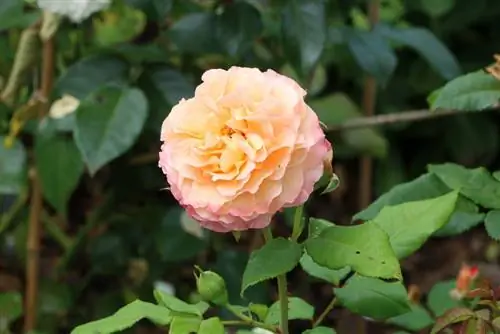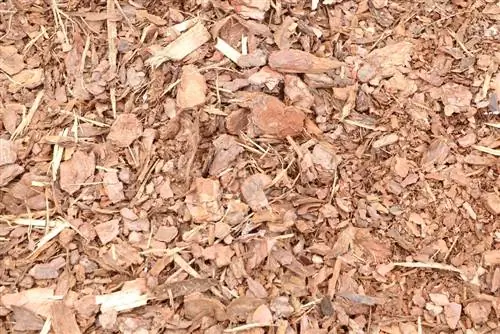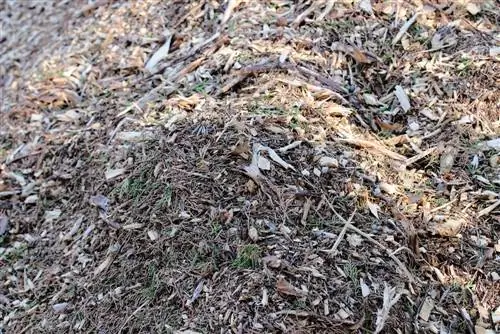- Author admin [email protected].
- Public 2023-12-17 03:39.
- Last modified 2025-01-24 12:45.
If rose gardeners take the right protective measures, winter will lose its terror for the queen of flowers. The crown, trunk, grafting area and roots benefit from a warm winter coat so that frost and snow do not cause damage. A proven basic principle using fleece, bark mulch, etc. sets the course. The specific procedure takes the respective rose type into account. This guide explains in detail and comprehensibly when and how you can winterize roses.
Why is winter protection recommended?
Many rose varieties suffer from limited winter hardiness for their lavish blooms. Blazing winter sun, bitter frost and drought stress put the resilience of roses to the test. Things become even more complicated when repeated changes between frosty and mild temperatures strain the plant tissue. Rose bushes should not be exposed to these hardships without protection. It is important to make the shoot base and grafting point winter-proof at the right time. For this purpose, prudent rose gardeners have a wide range of suitable materials at their disposal, tailored to the type of rose in question.
Preparations begin in summer
As a prologue to the expert winter protection of roses, the care program is modified in the summer. In order for young shoots to harden in time, the right supply of nutrients is important. Nitrogen is unfavorable as a growth engine at the end of the season. From August onwards, fresh shoots have no resistance to the first frosts and freeze back. Pathogens, rot and mold have easy access to these damaged areas, meaning that the affected rose is doomed. How to properly prepare roses for the upcoming winter:
- Stop giving nitrogen-rich rose fertilizer from July
- Instead, fertilize with patent potash at the end of August
- Alternatively, in July and August, baste the root slices with potassium-rich comfrey manure
One of the special properties of potassium is that the main nutrient strengthens the cell walls in plant tissue. This is particularly advantageous when constant temperature changes in combination with sunshine strain the tissue cells in winter. Furthermore, potassium is able to lower the freezing point in cell water.
Tip:
The starting signal for the perfect winter protection of your roses is given on the day they are planted. Plant the young bushes so deep that the grafting point is at least five centimeters below the ground. The neuralgic point can be recognized as a slight thickening in the transition from roots to crown shoots.
The ideal time is in November
North of the Alps, the window of opportunity for winter protection on roses opens at the beginning of November. As long as the golden October sun warms the bed and balcony, hasty measures run the risk of causing heat build-up. Only when the temperatures permanently fall below 10 degrees and move towards freezing point is the ideal time to prepare roses for the winter.
Pile up bed, bush and noble roses
Piling up the shoot bases plays a key role in winter protection for roses. The frost-sensitive area of the grafting site and branch base receives a natural bulwark against frost and moisture. How to do it right:
- Cover the shoot base of rose bushes 15 to 20 cm high with soil
- Ideally pile up with a mix of compost and topsoil
- Alternatively, lay out a coconut mat on a base layer of autumn leaves or straw
- Cover branches protruding from a mound of earth with coniferous twigs
The additional cover with coniferous twigs fulfills two tasks. In particular, densely needled branches slow down the icy east wind and prevent frost cracks caused by solar radiation. In addition, pine fronds add a decorative touch to the unsightly mounds of earth.
Note:
Bark mulch is unsuitable for piling up roses in the bed. First and foremost, the shredded bark of conifers releases an excess of tannic acid, which is not good for the noble ornamental trees. In addition, it proves to be a difficult undertaking to remove the decomposing bark mulch in spring.
Fleece hood shields crown
Winter protection for head-high shrub and noble roses requires further measures. Hilling up the base of the bush and a cover of coniferous twigs are not sufficient because the crown is not included or only partially included. Specialist retailers offer breathable fleece hoods for this purpose. Place the hood loosely over all rose shoots and pull the open end together above the piled-up soil with strings. Alternatively, wrap all branches with jute ribbons or a comparable, weatherproof and breathable fabric. Foil is not suitable as crown protection for roses. Condensation forms within a short time under the waterproof and airtight material, which inevitably causes rot.
Preparing tall trees for winter
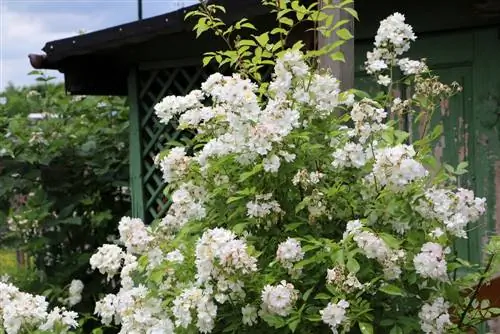
Opulent roses shine in the imaginative design of the bed and balcony, their picturesque crown enthroned on a trunk as a robust base. The sensitive finishing point is located at the base of the crown, which requires an alternative strategy for skilled winter protection. In addition, the trunk bark is at risk of stress cracks if warm rays of sunlight suddenly hit it on cold days. With a combination of crown and trunk protection, you can protect your rose trunk from the rigors of winter. This is how it works:
- Put the fleece hood over the crown
- Tie together on the trunk below the grafting point
- Wrap the trunk with jute or fleece ribbons
In harsh winter regions, we recommend additionally protecting the wrapped trunk with mats made of reed or coconut.
Tip:
Please do the last rose pruning of the season several weeks before the first frost. Rose bushes that have been cut shortly before the onset of winter are at massive risk from frost damage and even total failure. If in doubt, postpone pruning care until next spring. The best time for main pruning is when the forsythia is blooming.
Special case of climbing roses
The attempt to equip climbing roses with a hood is doomed to failure. Nevertheless, the long tendrils of climbers and ramblers should not go through the winter unprotected. Resourceful rose gardeners use the following options to guide roses on the trellis unscathed through the cold season:
- At the beginning, pile up the base of the bush to a height of 20 cm and cover with pine fronds
- Hang needle twigs in the climbing rose to break the icy wind
- Choose to set up winter protection mats made of coconut, reed, straw or heather root
There is no cause for alarm if isolated vines do not survive the winter. Roses are all easy to cut. Wait for this year's budding to identify frozen areas of wood. In April or May, cut the damaged climbing rose back to he althy wood as part of your annual pruning care. As long as the grafting site survives the winter he althy, a rose will sprout again vigorously.
Winter coat for buckets and boxes
In the planters, the root ball of a rose is in an exposed position and is vulnerable to severe frost. A thick winter coat and warm feet ensure that the roots do not freeze. How to winterize roses in pots and boxes:
- Relocate the bucket and box into a wall niche protected from the wind
- Place a wooden block, Styrofoam plates or plant rollers
- Cover the vessel with bubble wrap, jute, fleece or coconut mats
- Important: Leave floor openings free to protect against waterlogging
- Protect the crown with a fleece cap
- Cover the substrate with straw, coconut slices or compost soil
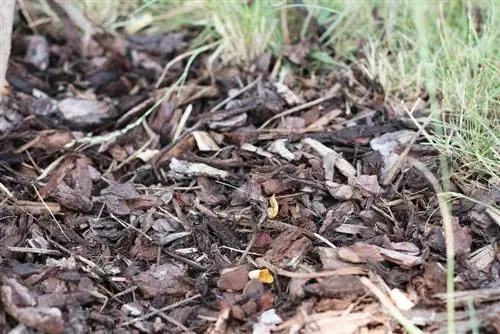
Ingenious balcony gardeners place the pots and boxes in a larger container or a jute sack and fill the cavities with bark mulch. Any winter protection will be ineffective if roses wither in pots and boxes. The soil dries out quickly in winter, especially in sheltered planters. On mild days, please check the moisture content of the soil using a thumb test so that you can water moderately when it is dry.
Remove winter protection precisely
A look at the calendar only provides limited information about when you should remove the winter protection from your roses. After all, the right time needs to be chosen carefully. In the worst case, an early date leaves the noble flowering bushes helpless in the event of late frosts. Winter protection that is removed too late poses the risk of rot and mold formation. The decisive clue for the ideal time comes from nature. When the forsythias bloom, winter protection for roses has fulfilled its duty.
No winter protection for wild roses and ground cover roses
You can remove protective measures for the winter from your care program if wild and ground cover roses decorate your garden. Both types of roses thrive without their roots and without a sensitive grafting area. In connection with a pronounced vigor and reliable winter hardiness, these rose forms fearlessly face the floral front of the cold season.

